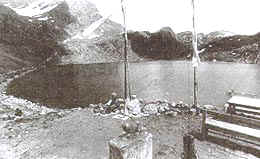

 |
 |
Besides Pashupatinath in Kathmandu, one of the holiest Hindu pilgrimages in the world; Lumbini, the birthplace of the Buddha in southern Nepal; and Janakpur, where Sita, consort of Lord Ram, was born, the Kingdom contains many other holy places which attract the faithful from all over.
BALMIKI ASHRAM. The Balmiki Ashram was a retreat used by the great Hindu sage Balmiki. This is where Sita came to live with her two sons Labha and Kusha after separating from Ram. Various statues were unearthed in the area during an archaeological excavation in the late 60s. A temple to Sita has been built recently.
The Ashram is situated in a forest on the bank of the Tribeni river, at the south-western corner of the Royal Chitwan National Park. It can be reached by boat.
BARAH CHHETRA is one of the four great Hindu pilgrimages. This is the spot where Barah, the boar incarnation of Lord Bishnu, protector of the universe, fought with the demon Hiranakshya and killed him. Apart from the main shrine dedicated to Barah, there are many other temples that bear the image of Bishnu’s boar incarnation.
Barah Chhetra is located at the confluence of the mighty Saptakoshi and Koka rivers, a few kilometers from the industrial town of Biratnagar in east Nepal. A religious fair takes place here in November.
DEVGHAT is where the Trisuli and the Kali Gandaki rivers meet to form the Narayani, a major tributary of the Ganga. Confluences of major rivers such as these are considered very holy.
Devghat is situated 6 km to the north of Bharatpur, the gateway to the Royal Chitwan National Park, where hotels are available. There are daily flights and bus services from Kathmandu. On the day of the Makar Sankranti festival in January, pilgrims converge here to take holy dips.
DHANUSHADHAM is a historical and religious site dating back to the time of the great Hindu epic Ramayan. Located 18 km to the northeast of Janakpur in south central Nepal, it was here that Lord Ram broke asunder Shiva’s divine bow - a condition for obtaining the hand of Sita in marriage. According to the epic, one of the three pieces fell in present-day Dhanushadham.
During the Makar Sankranti festival, hundreds of thousands of devotees from different parts of Nepal and India throng the Dhanusha temple at Dhanushadham to worship the fossilized bow frgament. In addition to the Dhanusha temple, there are two other temples dedicated to Ram and Ganesh in the vicinity.
GOSAIKUND lake is believed to have been created by Lord Shiva, when he thrust his trident into a mountain to draw water so that he could cool his burning throat after swallowing poison. There is a large rock at the center of the lake which is said to be the remains of a Shiva shrine.
Gosaikund (altitude 4,380 m) is situated to the north of Kathmandu on the Langtang trekking trail. The holy lake is a two-day trek from Dhunche (1,950 m) which is reached over an adventurous 118-km mountain road from Kathmandu via Trisuli Bazaar. Devotees gather here in hordes on the full moon day of August to take holy dips in the water. Small hotels and pilgrim shelters are available.
MANAKAMANA. The temple of Manakamana lies atop a 1,302-m hill. The deity is one of the manifestations of the Hindu Goddess Bhagawati who is believed to have the power to fulfill wishes. It is one of the most popular pilgrimage sites in Nepal.
Manakamana is situated 125 km to the west of Kathmandu. It is a steep three-hour hike to the hilltop from Abu Khaireni on the Kathmandu-Gorkha highway. Or you can take the cable car at Cheres, 104 km from Kathmandu on the highway to Pokhara. Package tours are available, and you can be back the same day. There are hotels at Manakamana if you want to stay the night.
MUKTINATH is held sacred by both Hindus and Buddhists. The main shrine is a pagoda-shaped temple dedicated to Lord Bishnu. Set into the wall around it are 108 water spouts from which pour holy water. The Jwala Mai temple nearby contains a spring and an eternal flame fed by natural gas spewing out of the ground.
Muktinath (altitude 3,800 m) is situated in north-central Nepal on the northern arc of the Annapurna Circuit trekking trail. It is a six-hour walk from Jomsom airport (2,713 m). Helicopter services are also available. There are pilgrim rest houses, lodges and restaurants at Ranipauwa nearby.
RIDI is second only to the Pashupatinath temple in Kathmandu in holiness. The Rikheswar Narayan Mandir situated here is the local version of the Pashupatinath temple with its auspicious cremation ghats.
Ridi is situated at the confluence of two rivers - the Kali Gandaki and the Ridi Khola - in mid-west Nepal. Devotees from Nepal as well as India throng here on Makar Sankranti for a ritual dip in the water. A 50-km dirt road links Ridi with the hill resort town of Tansen, where accommodation is available.
SIMRAUNGADH, capital of the former kingdom of Tirhut, is the seat of a rich civilization which peaked between the 11th and 14th centuries. The ancient city suffered terrible devastation at the hands of past invaders, but its cultural glory can still be seen in the archeological treasures that abound here. There are also many Hindu temples which draw pilgrims in large numbers.
Simraungadh is situated in the Terai plains directly to the south of Kathmandu. The most convenient access is from Birgunj (270 km by road from Kathmandu) where fine accommodation is available. You can also fly to Simara (15 minutes) and then drive to Birgunj (25 km) from where it is 49 km to Simraungadh.
MD Publishing Co.
Pvt. Ltd.,
Tripureswor, P. O. Box 3525, Kathmandu, Nepal.
Tel: 260327, 256003 . Telex: 2611 EMC NP. Fax: 977-1-261159.
E-mail:nttj@mos.com.np
Design and Maintained by Amaa Network Consultant, Inc.
Last Updated: 24 July, 2000
Comments and Suggestions to: Webmaster